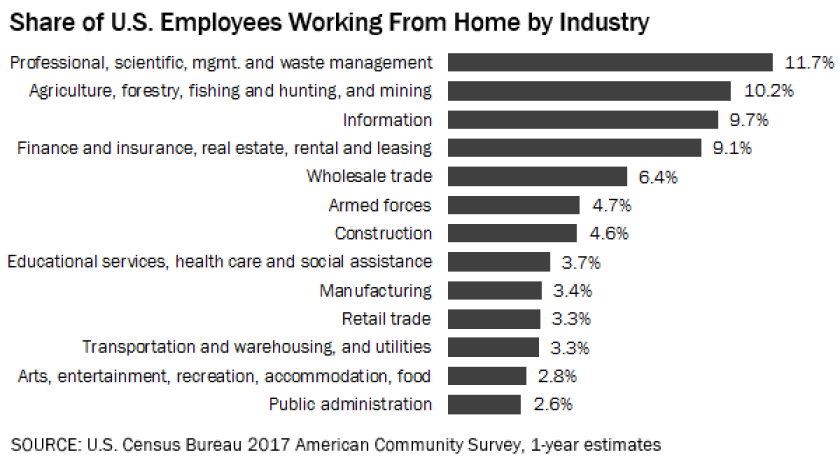The latest estimates from the U.S. Census Bureau published last week show that approximately 8 million workers primarily work from home. That makes telework now second behind only driving as the most common means of getting to work, exceeding public transportation for the first time.
Last year, an estimated 5.2 percent of workers in the American Community Survey reported that they usually telecommute, a figure that’s climbed in recent surveys. Meanwhile, the share of employees taking public transportation declined slightly to 5 percent and has remained mostly flat over the longer term.
The number of Americans telecommuting at least occasionally is much larger than what’s depicted in the federal data. That’s because the Census survey asks respondents to report how they “usually” go to work, meaning those working from home only a day or two each week aren’t counted. A 2016 Gallup survey found that 43 percent of employees spent at least some time working remotely.

Several factors contribute to this increase in telecommuting.
For one, some companies are encouraging employees to telework. Advances in technology have also made working remotely more practical than before. And tech-oriented areas of the economy support jobs more ideal for telecommuting than manufacturing, brick-and-mortar retail and other major industries where recent employment gains haven’t been as strong.
Those working from home at the highest rate -- 11.7 percent -- in the Census survey were classified as professional, scientific, management, administrative and waste management services workers. Other industries where telework is about as common include finance, insurance, real estate, agriculture and the information sector.

As one might expect, self-employed individuals are the mostly likely to work from their homes, with about 24 percent doing so last year. But they’re not driving the expansion of telecommuting. According to Census survey, there are fewer self-employed teleworkers who own unincorporated businesses than a decade ago, partially because the self-employed make up a smaller share (5.9 percent) of the overall workforce.
Instead, it’s employees of private companies who are pushing up telework numbers. According to the latest estimates, 4.3 percent of all private wage and salary workers usually worked from home last year, up from 2.7 percent a decade prior.
Additionally, older workers are significantly more likely to telework than younger age groups. The Census estimates indicate that 7 percent of workers age 60 to 64 worked from home, as well as 10.3 percent of those age 65 and over last year.
Meanwhile, several factors are suppressing public transportation ridership.
Perhaps what’s most to blame is an increase in car ownership. A recent study in Southern California concluded that increased vehicle access was the single most significant factor contributing to diminished transit use. Nationally, data suggests more adults living in poverty now have access to cars.
Other reasons often cited include the proliferation of ride-hailing services, lower gas prices and higher trip fares for some transit systems.
In the first quarter of this year, total transit passenger trips were down 3.9 percent from 2017, according to the American Public Transportation Association’s most recent ridership report, finding declines for all modes except for commuter rail.
Bus systems across the country have experienced particularly noticeable drops. The Maryland Transit Administration, Miami-Dade Transit Agency and Washington Metropolitan Area Transit Authority all reported year-over-year declines in bus passenger trips exceeding 10 percent in the first quarter. Many agencies have responded in recent years by reconfiguring bus routes and launching initiatives aimed at addressing inefficiencies in service.
Driving alone remains the predominant form of commuting. Just over three-quarters of employed workers reported driving to work in the 2017 Census survey, essentially unchanged from a decade ago.








